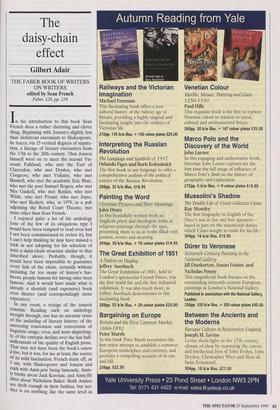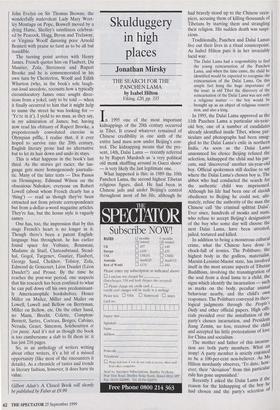The daisy-chain effect
Gilbert Adair
THE FABER BOOK OF WRITERS ON WRITERS edited by Sean French Faber, £20, pp. 216 In his introduction to this book Sean French does a rather charming and clever thing. Beginning with Jonson's slightly less than idolatrous encomium to Shakespeare, he traces, via 15 vertical degrees of separa- tion, a lineage of literary encounters from the 17th to the 20th century. Thus Jonson himself went on to meet the second Vis- count Falkland, who met the Earl of Clarendon, who met Dryden, who met Congreve, who met Voltaire, who met Boswell, who met the academic Eric Blair, who met the poet Samuel Rogers, who met Mrs Gaskell, who met Ruskin, who met Wilde, who met Proust, who met Joyce, who met Beckett, who, in 1979, in a pub adjoining the Royal Court Theatre, met none other than Sean French.
I enjoyed quite a lot of his anthology (one of the few of its ubiquitous type I would have been tempted to read even had I not been commissioned to review it), but I can't help thinking he may have missed a trick in not adopting for his selection of texts a daisy-chain structure similar to that described above. Probably, though, it would have been impossible to guarantee every link of the chain, certainly without including far too many of history's has- beens, people famous for having once been famous. And it would have made what is already a shortish (and expensive) book even shorter (and correspondingly more expensive).
In any event, a vestige of the conceit remains. Reading such an anthology straight through, one has an uncanny sense of the unfurling of literary history; of the unceasing renovation and reinvention of linguistic usage; even, and most dispiriting- ly, of the entropic decline over the last half- millennium of the quality of English prose. That may not have been the book's raison d'etre, but it was, for me at least, the source of its mild fascination. French starts off, as I say, with Shakespeare and Janson and ends with Amis pere being famously, Amis- 13 bitchy about Jack Kerouac, and Amis fils ditto about Nicholson Baker. Both Arnises are droll enough in their fashion, but nei- ther is on anything like the same level as John Evelyn on Sir Thomas Browne, the wonderfully malevolent Lady Mary Wort- ley Montagu on Pope, Boswell moved by a dying Hume, Shelley's saintliness celebrat- ed by Peacock, Hogg, Byron and Trelawny, or Virginia Woolf damning poor Arnold Bennett with praise so faint as to be all but inaudible.
The turning point arrives with Henry James. French quotes him on Flaubert, Du Maurier, Zola, Stevenson and Rupert Brooke and he is commemorated in his own turn by Chesterton, Woolf and Edith Wharton (who, in the book's sole laugh- out-loud anecdote, recounts how a typically circumlocutory James once sought direc- tions from a yokel, only to be told — when it finally occurred to him that it might help to name the street he was looking for — 1/e're in it'). I yield to no man, as they say, in my admiration of James; but, having now read his obituary of Rupert Brooke, a preposterously convoluted exercise in Olympian piffle, I realise that, if it ever hoped to survive into the 20th century, English literary prose had no alternative but to let its hair down and undo its stays.
This is what happens in the book's last third. As the stories get racier, the lan- guage gets more homogenously journalis- tic. Many of the later texts — Dos Passos on Hemingway, Edmund Wilson on the obnoxious Nabokov, everyone on Robert Lowell (about whom French clearly has a `thing') — read as though they've been extracted not from private correspondence but from a-dollar-a-word magazine articles. They're fun, but the house style is vaguely samey.
One has, too, the impression that by this stage French's heart is no longer in it. Though there's been a patent English- language bias throughout, he has earlier found space for Voltaire, Rousseau, Madame de Stael, Chateaubriand, Stend- hal, Gogol, Turgenev, Gautier, Flaubert, George Sand, Chekhov, Tolstoy, Zola, Edmond de Goncourt, Leon Daudet (Leon Daudet?) and Proust. By the time he reaches the post-war period, one suspects that his research has been confined to what he can pull down off his own predominant- ly Americanophile bookshelves. Hence Miller on Mailer, Miller and Mailer on Lowell, Lowell and Bellow on Berryman, Miller on Bellow, etc. On the other hand, no Mann, Brecht, Colette, Compton- Burnett, Sartre, Cocteau, Borges, Calvino, Neruda, Genet, Simenon, Solzhenitsyn et j'en passe. And it's not as though the book is too cumbersome a slab to fit them in: it has just 216 pages.
So, as an anthology of writers writing about other writers, it's a bit of a missed opportunity (like most of the encounters it details). As a chronicle of tastes and trends in literary fashion, however, it does have its value.
Gilbert Adair's A Closed Book will shortly be published by Faber at £9.99.



























































































 Previous page
Previous page